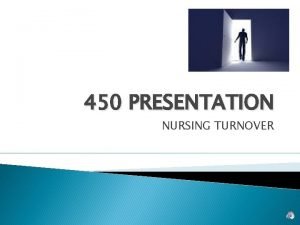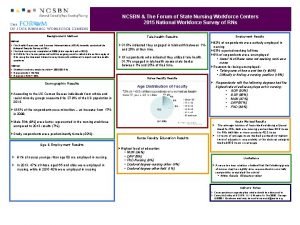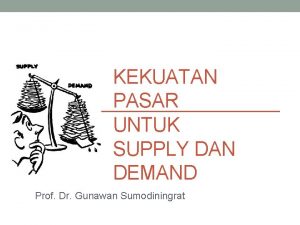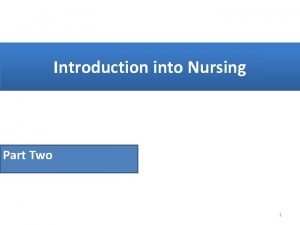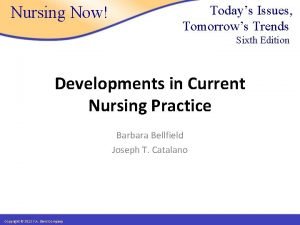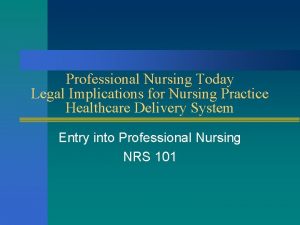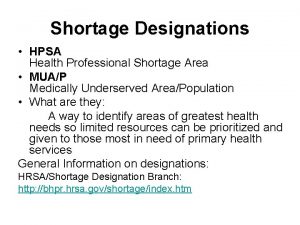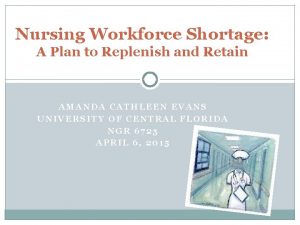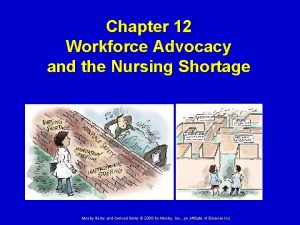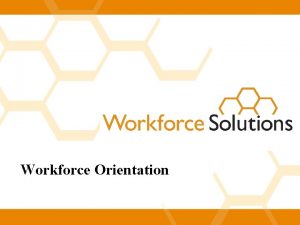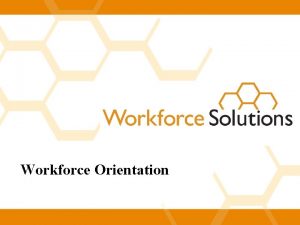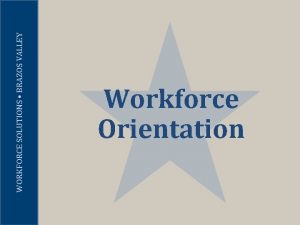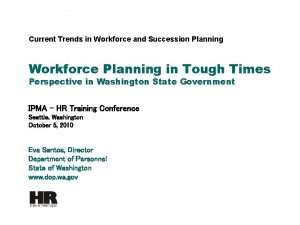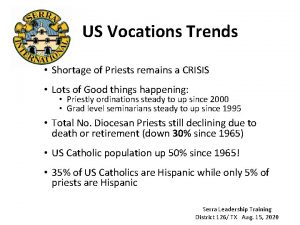MODULE 5 NURSING WORKFORCE TRENDS The Nursing Shortage


































- Slides: 34

MODULE 5 NURSING WORKFORCE TRENDS

The Nursing Shortage is Back

Healthcare’s Crisis A Perfect Storm An Aging Population + Reimbursement Challenges + Workforce Shortages

Key Trends • ANM Healthcare found it a 2015 study that 62% of nurses older than 54 were considering retirement now that the economy has improved. • Turnover is increasing nationwide – now at 14. 8% for Hospital RNs (20% For-Profit Hospitals) and 19. 2% for Surgical Specialties (NSI Nursing Solutions 2017) • 22. 7% of hospitals now report vacancies of more than 10% for RNs (NSI, 2017) • Greatest turnover is in the first year of practice – 25. 6% and 51% within 2 years.

Veterans 1920 -1943 59 m 5% Workforce Declining Boomers 1944 -1960 Gen X 1961 -1980 76 m Gen Y or Millennials 1981 -2000 78 m 46 m 30% Workforce 32% Workforce 33% Workforce Growing – will be 50% by 2020

Millennials or Gen Y Born 1981 -2000 • Digital natives – 6 th sense • Optimistic • Civic minded • Collaborative • Need feedback • Loyal to teams/leaders • Want career coaching – desire “a plan” for their future • Satisfied with nursing as a career but least satisfied generation with their current employers. • Have a very unique perspective about the need of organizations to “accommodate them”. • Most likely generation to return to graduate school. SLIDE 6

http: //www 2. deloitte. com/global/en/pages/about-deloitte/articles/millennialsurvey. html

http: //www 2. deloitte. com/global/en/pages/about-deloitte/articles/millennialsurvey. html


http: //www 2. deloitte. com/global/en/pages/about-deloitte/articles/millennialsurvey. html

Generation Y – Highest Stress Level Stress in America APA 2012

Work-Life Balance Boomers – Work First Gen X- Work 50% Life 50% Gen Y – Life First

Younger Nurses More Likely to Pursue Higher Education AMN Healthcare conducted a nursing workforce survey in 2015. Close to 9000 RNs responded. ¾ of nurses under 40 reported that they plan to seek a higher degree in the next 3 years. 36% plan to seek an advanced practice degree. AMN Healthcare (2015). 2015 Survey of Registered Nurses. Available at www. anmhealthcare. com Rose O Sherman 2016

The Triple Aim

Movement to the Quadruple Aim

AACN Healthy Work Environments AACN, 2016 2 nd Edition http: //www. aacn. org/wd/hwe/content/hwehome. pcms? menu=hwe


Assertion #1 § There is a direct link between work environment and patient safety § Therefore, if we are not addressing our work environment, we are not addressing patient safety

Assertion #2 § Healthy work environments do not just happen § Therefore, if we do not have a formal program in place addressing work environment issues, little will change

Assertion #3 § Creating healthy work environments requires changing long-standing cultures, traditions and hierarchies § Therefore, though everyone must be involved in the creation of healthy work environments, the onus is on organizational, departmental and unit leaders to ensure that it happens

Creating the “case” for a healthy work environment… Are There Challenges? Challenges to the Case for Healthy Work Environments § Link to patient safety not universally recognized § Relationship issues seen as “soft” § Hierarchy and power structures § Difficult to measure improvements § Tradition § Not a “sexy” issue

Call to Action § Nurses and all health professionals Embrace, develop, follow through § Healthcare organizations Adopt, implement, evaluate, role model § AACN and the community of nursing Promote, develop, publicize

It Starts with Us “Creating a healthy work environment is more than a thing to do. It is a way of being that relies on the strength of the entire team. The culture becomes compromised when any part of the team fails to support a standard. ” AACN 2016

The Risk of Burn Out

What is Burnout? Burnout syndrome is a state of emotional, mental and physical exhaustion caused by excessive and prolonged stress. This exhaustion is typically workrelated and is triggered by discrepancies between the expectations and the actual requirements of the job. Burnout syndrome has become a common worldwide phenomenon, especially among members of high-stress professions, such as firefighters, police officers, teachers and all types of health-care professionals. Critical Care Collaborative July 2017

New Study Critical Care Collaborative July 2016 • Up to 45 percent of critical care physicians reported symptoms of • • severe burnout syndrome, while those specializing in pediatric critical care were at 71 percent. Approximately 25 to 33 percent of critical care nurses manifest symptoms of severe burnout syndrome, and up to 86 percent have at least one of the three classic symptoms. The high burnout syndrome rate in critical care professionals can be attributed to the especially stressful environment in the ICU due to high patient morbidity and mortality, challenging daily work routines, and regular encounters with traumatic and ethical issues. Burnout syndrome in critical care health care professionals may result in posttraumatic stress disorder, alcohol abuse and even suicidal thoughts. In nurses, burnout is associated with reduced quality of care, lower patient satisfaction, increased number of medical errors, higher rates of health care associated infections, and higher 30 -day mortality rates. http: //www. aacn. org/wd/publishing/content/pressroom/pressreleases/2016/jul/burnoutcritical-care. pcms? menu=aboutus

Signs of Burnout • Chronic fatigue • Forgetfulness – Inability to concentrate • Physical issues – Increased use of sick leave • Anxiety or depression • Anger • Cynicism and disengagement from work

Work Engagement • The Gallup Organization reports that only 30% of the US workforce is engaged in their work. • Nursing Advisory Board (2014) reported only 32% of RNs are engaged in their work.

The Energy Bus Gordon, J. (2007). The Energy Bus. New Jersey: Wiley Publishers

Strategies to Promote Engagement üPromote identification with the mission, vision and values of the organization. üBuild a sense of community on units. üHelp staff find joy in the work. üBuild trust and a sense of psychological security. üProvide recognition and an opportunity for growth.

Promote Civility and Stop Bullying

The Evidence on Bullying and Incivility • Bullying decreases job satisfaction and morale and increases absenteeism (Chipps & • • • Mc. Rury, 2012) Almost 21% of nursing turnover can be related to bullying (Johnson & Rea, 2009) 60% of new RNs who quit their first job in nursing within 6 months report that it is because of being bullied Replacing one nurse can cost up to $88, 000 USD (Jones, CB, 2012) According to a study by the US Bureau of National Affairs, there is a loss of productivity of $5 -6 billion/year in the US due to bullying in the workplace. In a study on workplace bullying, most of the respondents reported being bullied by the charge nurse, manager, or director (Johnson & Rea 2009). One in six nurses (13%) reported being bullied in the past six months (Sa & Fleming 2008) Bullying of nurses leads to erosion of professional competence as well as increased sickness, absence, and employee attrition (Hutchinson et al. , 2010; Johnson, 2009) Bullying victims may suffer stress-related health problems, such as nausea, headache, insomnia, anxiety, depression, weight changes, and alcohol and drug abuse (Townsend, 2012) Nurses who survive bullying early in their careers tend to carry their learned behaviors with them. They accept the bully culture as part of the job and eventually may choose to bully other nurses (Townsend, 2012) The Joint Commission (2008) acknowledges that unresolved conflict and disruptive behavior can adversely affect safety and quality of care Assessing the work environment for the presence of incivility and bullying is a leadership imperative. Ignoring a culture in which this exists will continue to drain our financial resources and ultimately harm our

What Leaders Can Do 1. Examine your own behavior and how you contribute to civility or incivility. 2. Take a temperature check in your unit to see how staff treat one another. 3. Don’t listen to or tolerate rumors and gossip. 4. Encourage staff not to jump to conclusions about the intent or motives of other staff, patients or families. 5. Stop the blame game and encourage a solutions orientation to problems. 6. Encourage acts of kindness among staff. 7. Go out of your way to say thank you and promote this behavior in staff. 8. Look for common ground in dealing with conflict. 9. Encourage the practice of forgiveness. 10. Make it safe for staff to ask questions and discuss problems.

For Help - http: //www. stopbullyingnurses. com/
 English
English Pico question nursing shortage
Pico question nursing shortage National forum of state nursing workforce centers
National forum of state nursing workforce centers Theme of minerva writes poems
Theme of minerva writes poems Surplus shortage
Surplus shortage What is there a shortage of on mango street
What is there a shortage of on mango street Expected shortage per replenishment cycle
Expected shortage per replenishment cycle History of fashion marketing
History of fashion marketing Expected shortage per replenishment cycle
Expected shortage per replenishment cycle Da pamphlet 710-2-1
Da pamphlet 710-2-1 Transistor shortage
Transistor shortage Shortage or surplus
Shortage or surplus Is there a teacher shortage in georgia
Is there a teacher shortage in georgia Note of protest
Note of protest Anong ibig sabihin ng price ceiling
Anong ibig sabihin ng price ceiling Shortage artinya
Shortage artinya Definition of scarcity in economics
Definition of scarcity in economics Inventory pooling
Inventory pooling Expected shortage per replenishment cycle
Expected shortage per replenishment cycle Role of safety inventory in supply chain
Role of safety inventory in supply chain Kurva surplus dan shortage
Kurva surplus dan shortage C device module module 1
C device module module 1 Trends in pediatric
Trends in pediatric Nursing now today's issues tomorrow's trends
Nursing now today's issues tomorrow's trends Trends and issues in nursing
Trends and issues in nursing Nursing now today's issues tomorrow's trends
Nursing now today's issues tomorrow's trends Legal implications in nursing practice
Legal implications in nursing practice Introduction modern concept of child care
Introduction modern concept of child care Mật thư tọa độ 5x5
Mật thư tọa độ 5x5 Chụp phim tư thế worms-breton
Chụp phim tư thế worms-breton ưu thế lai là gì
ưu thế lai là gì Thẻ vin
Thẻ vin Thể thơ truyền thống
Thể thơ truyền thống Bàn tay mà dây bẩn
Bàn tay mà dây bẩn Các châu lục và đại dương trên thế giới
Các châu lục và đại dương trên thế giới

